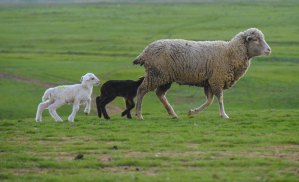Filter by Topic:
Posted by Tony Bithell on Feb 18, 2016
With lambing season upon us, dog walkers and owners need to take extra care when out and about within the countryside.
 Around 16 million lambs are born in the UK every year, resulting in January to April being one of the busiest times in the whole farming calendar. Every Spring, fields and mountains across the country are filled with ewes and new born lambs, reminding us that winter is over and that the warmer summer weather will soon be upon us.
Around 16 million lambs are born in the UK every year, resulting in January to April being one of the busiest times in the whole farming calendar. Every Spring, fields and mountains across the country are filled with ewes and new born lambs, reminding us that winter is over and that the warmer summer weather will soon be upon us.
Sadly however, the number of attacks on livestock has increased and consequently many sheep are being attacked, injured or killed. The National Sheep Association (NSA) has reported a considerable increase in the number of dog attacks on livestock and this is causing a major animal welfare problem within the UK. The NSA is particularly concerned about heavily pregnant ewes or those that have lambs at foot.
As described by the Dogs (Protection of Livestock) Act 1953, the worrying of livestock by dogs is illegal and, of course, is of great concern to farmers for many obvious reasons. The word worrying in this context means the attacking or chasing of livestock in such a way that could result in injury, suffering, abortion or loss of produce. Similarly, a dog being at large, in a field where there are sheep (which includes a dog not being kept on a lead or being kept under close control) may also be considered a breach of this act.
Of course our four legged companions (although dogs are usually domesticated) do have a strong predator drive and it is inherent in them to chase livestock, especially sheep! They may chase sheep simply to play with them or sadly sometimes their intent is to kill. As a result, all dogs are described as having the capability to be aggressive. Many dog behaviourists believe that dogs that chase livestock can be trained to stop doing so, with the right training plan and owner commitment.
It goes without saying that dogs that do chase sheep can have a detrimental affect upon their victims. For example, pregnant ewes can abort their lambs due to this stressful experience and young lambs can often be separated from their mothers during a chase and may sadly die of starvation and/or hypothermia, having been abandoned.
Surprisingly, a recent study conducted by NFU Mutual in 2015, has reported that 35% of a farmers overall cost base, can be directly attributed to dogs attacking their livestock!
Dog walkers’ responsibilities
It may be difficult to take your dog for a walk in the countryside though and then expect to completely avoid meeting with livestock at some point. Whether dog walking through legal right of ways across open land or perhaps through valleys or over hills, sheep may well be present. So, as a dog walker what steps can you take? Well, there are certain responsibilities to be aware of when you find yourself in the company of livestock, some of which are listed below:
- do keep your dog on a lead and under your strict control
- ensure your dog is docile and obedient
- don’t allow your dog to chase or take an interest in sheep – or cute lambs!
- do be in charge and have full control at all times
- train your dog not to be aggressive when around sheep
- don’t be complacent – and stay alert at all times!
Remember, under the Dangerous Dogs Act 1991, dog owners may face prosecution (often resulting in severe penalties) and also a dog may sadly be shot, if it is found to be chasing a farmer’s livestock!
Farmers’ responsibilities
Although farmers may have permission to shoot on sight when they see a dog chasing their sheep, initially they should take action to avoid this situation, by warning dog walkers of the presence of livestock! The killing or injuring of any person’s dog may result in a farmer facing criminal damage charges and possibly further investigations into the legal ownership of firearms. In addition, the RSPCA will carry out investigations into any dog shooting, to ensure that there was no unnecessary suffering caused to these protected animals (i.e. dogs) under Section 4 of the Animal Welfare Act, 2006. Obviously, the shooting of any dog should be the very last resort!
Farmers responsibilities include:
- putting up RSPCA dedicated signs to warn dog owners that livestock is present or may be grazing
- report (however small) all dog chasing incidents to the police, to prevent future incidents
- keeping pregnant sheep and young lambs away from public footpaths (wherever possible)
Well, we trust that the above information may be of some benefit to you and we wish all of our four legged friends, dog walkers and farmers alike a very pleasant and enjoyable time outdoors, wherever you may be!